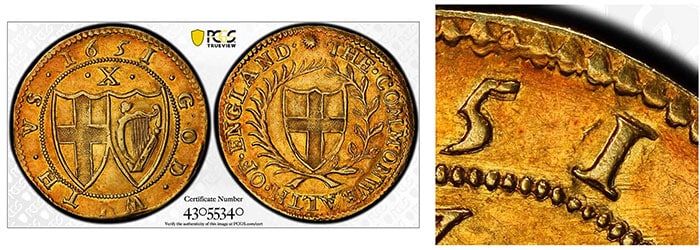By Jay Turner for PCGS ……
This month has been active with several new varieties being added to the PCGS database and census. These include an incredible doubled die from Germany and a new doubled die for the popular Mexico Onza series, along with some other interesting varieties.

The first new variety now recognized by PCGS is a Germany Weimar Republic 1925-D 3 Reichsmarks. This coin is a circulating commemorative issue celebrating the 1,000th anniversary of the Rhineland. This coin, issued with a D mint mark for Munich, boasts a listed mintage of 252,027.
This example, however, is different, featuring a very strong doubled die obverse. This doubled die is most noticeable on the “25” of the date. Other features, such as the hand of the armed figure and the eagle’s wing in the arms of the shield, also feature more minor doubling. Yet, it is the strong doubling on the date that makes this variety something of note.

The next variety comes in the popular Onza or Libertad series, which went neglected for decades before collectors started to realize how diverse and scarce the series is to collect and how rare high-grade example are. The 1983 issue being the second date has a mintage of 1,001,768 listed. An example was recently submitted to PCGS with a doubled die on the Winged Victory side. This doubled die shows moderate doubling on the “1 ONZA” within the digit and the “ON” and on “PLATA PURA”. Extra thickness can also be seen on some of the other lettering.
PCGS currently has certified only two examples of this variety.

Another interesting Mexican variety is an 1880-CH G 10 Centavos. Mexico is full of interesting varieties that are just now starting to get attention. This coin from the Chihuahua Mint–which can come Ca or CH–features the assayer’s initial “G” being initially punched with a smaller digit then corrected with a larger letter “G”.
While this variety is known and documented, even in the Krause catalog, this is the first example submitted to PCGS for certification.

While early British coins are very collectible and many varieties are documented, this very cool Commonwealth gold coin was recently submitted featuring an overdate. Commonwealth gold double crown coins were first minted in 1649 and production ceased in 1657. This example, minted in 1651, features a die that originally was from 1650 and recycled adding a 1 over the 0 and not fully removing the previous digit that went into production. But even though this overdate is noted by auction houses, it is neglected by many major British references.
This exact coin was noted as an overdate as early as 2003 when it was sold by Classical Numismatic Group (CNG) and since made appearances in auctions in 2012, 2018, and 2021 with the overdate noted. When the coin was crossed over to PCGS, it was the first example of the overdate certified by the company.
* * *





